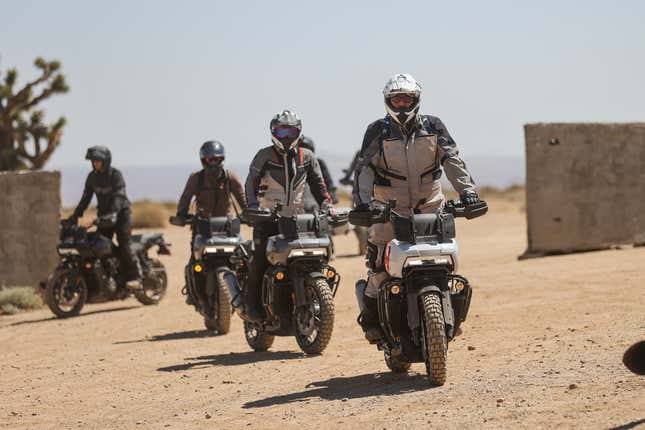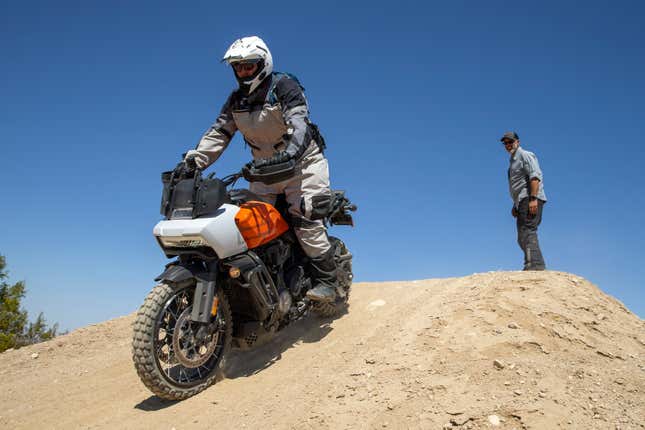About a decade ago, RawHyde Adventures kicked off as a guided tour through the Mojave desert from Los Angeles to Las Vegas. It took eight days, and it was incredibly taxing on bike and rider alike. Jim Hyde, the guy who started it all, noticed that ADV bikes and dual sports were increasingly purchased by people without the skills to just jump on and head out into the desert. So he started a training school to help folks learn what they needed to know before going hog wild and ending up hurt with a broken bike, or worse.
(Full Disclosure: Harley-Davidson invited me to warm Mojave, California, to ride its new Pan America motorcycle. I paid for my travel, driving my own car rather than flying. Harley provided a day of off-road riding school with RawHyde, plus some great food and two nights of sleeping quarters in a shipping container in the desert. That doesn’t sound half as cool as it was, I promise.)
I think it’s important to give some context here as to my off-road riding experience. It’s very little. I used to ride quads and dirt bikes when I was a youngster, but that’s been ages now. In recent years having lived in Reno for a while, I have picked up a bit of hard-pack Jeep trail riding, and I have done a little (very little) dirt bike riding out at an ORV park northeast of town. Just the week before this off-road school, I went on a two-day off-road camping adventure with a Zero DSR to give myself a baseline brush-up before committing to this class. More on that later.
When I first drove out to the RawHyde’s ZAKAR compound, I thought I’d gotten lost. The stretch of desert between Mojave and California City is totally barren, just wide open nothing as far as you can see. Mountain ranges scatter the far edges of your vision. It looks more like the moving background of a mid-2000s sandbox video game than real life. My phone told me to turn off the highway onto a road that took me a few minutes to actually find. It wasn’t so much a road as a dirt path, and my low-riding Porsche jostled me on our way up to the main gate before scraping pan on the speed bump at the entrance.

We’re out in the middle of nowhere, and we’re going to learn to ride motorcycles, dammit.
The first night was an introduction to the new Pan America and all of the fancy new tech Harley developed for it. It’s a terrific looking bike, and it rides pretty great, too. For the most part, if you’re learning to ride off road, I don’t recommend starting your sojourn with a 500 pound motorcycle with 150 horsepower, but the whole point of this class is to learn ADV riding techniques to get you across a desert in one piece.
The following day opened with a very important lesson for every dirt rider. “Everyone here is going to drop a bike today. That’s nothing to worry about. We’re going to show you how to pick it back up. And how to do that safely.” These big heavy bikes are a bit of a pain to lift on your own. The traditional bike-lifting technique of turning your back to the bike and walking it straight up is still the answer.
This time, however, using a second person as a counterbalance makes the weight more manageable. As you can see in the picture above, a second rider is standing on the rear wheel with a grip on an upper fixed point of the bike. On the count of three, the lifter starts walking the bike up, and the counterweight person thrusts their butt out and tries to sit down on the ground. Boom. Done.

Once that was over, we got to the drills.
A full day of running motorcycle drills standing on the pegs is a tough day. The school recommended bringing a camelback, and I’m glad I did. It’s a dry heat, and it’ll sap your concentration faster than you might think. Stay hydrated on a desert adventure, because you might make a dumb mistake without it.
We started out slow, running up and down a dirt road standing on our pegs in first gear at low speed. As that became more comfortable, we began shifting our weight around to feel what it was like to put the weight on the left peg, then the right peg. Still riding in a straight line, we began moving our entire bodies over to one side or the other, dropping down to dip a right foot in the dirt on the left side, and vice versa.

Even little things that you wouldn’t think are skills you’d ever need are taught. To learn the balance points of the motorcycle, we walked a full 360 degrees around the bike keeping it standing upright with just two fingers grabbing a piece at a time. Bikes want to stand up, and it’s important to learn just how it likes to stay standing.
Once we knew the balance points, and how to ride in a straight line, we started learning panic braking drills. I don’t recommend ever doing this on the street, but out in the dirt you need to know how your bike reacts to a full-force braking event. First we learned how the bike handles a panic stop on dirt with the ABS engaged, back brake only, front brake only, then both. Then we did the same drills with ABS fully off. So many riders, myself included, are afraid of the front brake on dirt, particularly downhill. These drills taught me exactly how the brakes operate at their max, and I was much more comfortable and confident using the right lever from that point on.

Next up was the weaving cones course, where a series of coned gates were set up to run through. A short slow series of sandy hairpins were there to teach us about the importance of weight transfer and balance on dirt. It seems so counterintuitive for street riders, but you actually want your weight to the outside of the corner. In the picture above, you can see the technique in action. Point your outside toe towards the bike, use your outside knee to press into the tank, and shift your butt to the outside of the seat.
I had to throw out much of what I knew about riding to get this one down, but it makes sense. You want to keep as much of the weight of the bike and rider straight up and down in relation to the tires. Even if the tires are leaned over to one side or the other, you want the weight to be perpendicular to the ground. As soon as you put lateral force into the tire, that’s where you get slip angle. On the street lateral force just pushes the tire into the pavement, but on dirt, you end up pushing your ass into the dirt.

Next, the school linked some uphill and downhill drills into the loop with the cone course. With two little dirt hills built up, we learned how to go downhill into an uphill, carrying that momentum to crest the top. Then we’d turn a corner and crawl into an uphill. We stopped at the top of the second hill and then tried to go down the face of the second hill as slowly as possible by feeding in as much brake as we could without locking up. That was fun stuff!

The last official drill of the day was a run through this section of sand whoops. With everything we’d learned up to this point, plus the confidence earned by riding a full day in the saddle, new skills came easier and faster. Dirt turns and braking and skids and hard acceleration all culminated in a slew of folks who suddenly knew what they were doing. While I’m sure some of my media co-horts on this trip were more advanced dirt riders than I before this event, I feel like we all learned a lot over the course of the day.

The last two segments of the day were totally optional, and I chose to take advantage of both of them. The first was a full-bore run through the sand pit from hell. The instructors gave us all the tips we needed to go at this thing, but only about four people actually participated. It was a very deep sand pit, around two or three feet of soft flowing sand. It’s more or less like the video below. Sand is going to whip your handlebars around, so you have to be loose and keep your eyes up with your weight shifted back. It was pretty gnarly, but I managed to make it through the hell pit without dropping the Harley. I’m confident that if we’d started the day there, I’d have been on my butt in the sand faster than you can say Revolution Max engine.
As a way to link all of our new skills together in one totally awesome event, we ran our big Wisconsin-built bikes down to the local motocross track. This track had everything from big banked berm turns, whoops, and kicker jumps to deep sand, hard pack dirt, and rock. This was a ton of fun, and further helped to build my confidence on the bike. I managed to get in about 15 laps of the short circuit before my lack of endurance caught up to me. It’s not easy manhandling a 500-pound bike in the dirt, and after a full day in hot sweaty gear, I was bushwhacked.

In all, my time at the Jim Hyde’s “Zombie Apocalypse Kompound At RawHyde” (ZAKAR) was time well spent, and I now feel much better about my abilities I gained as a rider. Whether you’re new to desert ADV riding or you just want to learn some skills and get more seat time on bikes like this, it’s probably worth your time and not-inconsiderable amount of money to get out and experience the adventure. What I took was a condensed one-day course, followed by a trip up into the mountains with some trail riding the next day. The school offers some intense three-day training courses for $1,495 if you bring your own bike, but they do have bikes available for rent if you aren’t sure about buying your own.

As RawHyde proudly touts, about a third of our roads here in the U.S. are unpaved. If you want to get anywhere adventurous, you’re probably going to have to take those roads. If you leave the States, that percentage skyrockets. For example, 60 percent of Canada is unpaved, and 93 percent of Bolivia. Adventure riding is a growing segment of the motorcycle market, and if you are looking to get in on the ADV crowd, this isn’t a bad place to start. In fact, I’m already considering going back for the next level of training. It’s a cool place, and a fun time. Plus the bikes are rad.


